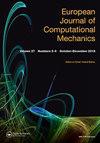A Novel Differential Quadrature Galerkin Method for Dynamic and Stability Behaviour of Bi-directional Functionally Graded Porous Micro Beams
IF 0.6
Q3 MECHANICS
引用次数: 0
Abstract
The free vibration and buckling behaviours of 2D-FG porous microbeams are explored in this paper utilizing the Quasi-3D beam deformation theory based on the modified couple stress theory and a Differential Quadrature Galerkin Method (DQGM) systematically, as a combination of the Differential Quadrature Method (DQM) and the semi-analytical Galerkin method, which has used to reduce computational cost for problems in dynamics. The governing equations are obtained using the Lagrange’s principle. The mass and stiffness matrices are calculated using the weighting coefficient matrices given by the differential quadrature (DQ) and Gauss-Lobatto quadrature rules. The matrices are expressed in a similar form to that of the Differential Quadrature Method by introducing an interpolation basis on the element boundary of the Galerkin method. The sampling points are determined by the Gauss-Lobatto node method. The influence of the thickness-to-material length scale parameter (MLSP) on the nondimensional natural frequencies and nondimensional critical buckling loads of 2D-FG porous microbeams are investigated, along with the effects of the boundary condition, aspect ratio and gradient index. The results are validated with literature to establish the accuracy of the procedure described. This work will provide a numerical basis for the design of FG microstructures in the field of micromechanics. These results can be applied to the engineering design of porous FG microstructures.研究双向功能梯度多孔微梁动态稳定性的微分正交伽辽金方法
本文采用基于修正耦合应力理论和微分正交伽辽金法的准三维梁变形理论,系统地研究了二维fg多孔微梁的自由振动和屈曲行为,将微分正交法和半解析伽辽金法相结合,降低了动力学问题的计算成本。利用拉格朗日原理得到了控制方程。利用微分正交(DQ)和高斯-洛巴托正交规则给出的权重系数矩阵计算质量矩阵和刚度矩阵。通过在伽辽金法的单元边界上引入插值基,将矩阵表示成与微分求积法类似的形式。采样点由高斯-洛巴托节点法确定。研究了厚度-材料长度尺度参数(MLSP)对2D-FG多孔微梁无量纲固有频率和临界屈曲载荷的影响,以及边界条件、展弦比和梯度指数的影响。结果与文献验证,以建立所述程序的准确性。该工作将为微力学领域中纤维纤维微结构的设计提供数值依据。这些结果可应用于多孔FG微结构的工程设计。
本文章由计算机程序翻译,如有差异,请以英文原文为准。
求助全文
约1分钟内获得全文
求助全文

 求助内容:
求助内容: 应助结果提醒方式:
应助结果提醒方式:


